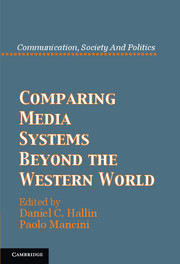Book contents
- Frontmatter
- Contents
- Contributors
- 1 Introduction
- Part I Cases
- 2 The Impact of National Security on the Development of Media Systems
- 3 Italianization (or Mediterraneanization) of the Polish Media System?
- 4 Culture as a Guide in Theoretical Explorations of Baltic Media
- 5 On Models and Margins
- 6 Africanizing Three Models of Media and Politics
- 7 The Russian Media Model in the Context of Post-Soviet Dynamics
- 8 Understanding China's Media System in a World Historical Context
- Part II Methods and Approaches
- References
- Index
5 - On Models and Margins
Comparative Media Models Viewed from a Brazilian Perspective
from Part I - Cases
Published online by Cambridge University Press: 05 June 2012
- Frontmatter
- Contents
- Contributors
- 1 Introduction
- Part I Cases
- 2 The Impact of National Security on the Development of Media Systems
- 3 Italianization (or Mediterraneanization) of the Polish Media System?
- 4 Culture as a Guide in Theoretical Explorations of Baltic Media
- 5 On Models and Margins
- 6 Africanizing Three Models of Media and Politics
- 7 The Russian Media Model in the Context of Post-Soviet Dynamics
- 8 Understanding China's Media System in a World Historical Context
- Part II Methods and Approaches
- References
- Index
Summary
The publication of Hallin and Mancini's book Comparing Media Systems was a turning point for comparative media studies. Given the tremendous impact of the book, the question soon arose whether it would be possible to apply the categories proposed by Hallin and Mancini in a broader, worldwide comparative effort. The authors themselves discuss this possibility in their book. On the one hand, they recognize that the consistency of the models they proposed is indebted in part to the fact they have studied a relatively limited and homogeneous group of countries (2004a: 6). On the other hand, they show some optimism in this regard, given that they believe that the models that exist in Western Europe and North America tend to prevail also in the rest of the world. In this chapter, I critically examine the categories proposed by the authors, and this proposition in particular, with a focus on the Brazilian media system.
In the first part of the chapter, I discuss the three-model system both from a theoretical and a methodological point of view. Two main problems are of concern. The first refers to the very concept of “model” as used by the authors. I argue that when they suggest that the Western models “tend to be dominant globally” they are in fact using two very different concepts of a model. When they apply the term to the Western countries, they use it in the sense of “models from…” – that is, methodological entities that exist only as research tools. When they apply the term “model” to non-Western countries, however, its status changes and becomes a “model to…” – that is, normative parameters that are used in the real world. The second problem refers to the way Hallin and Mancini define the Polarized Pluralist model and, in particular, their suggestion that it would explain some traits of media systems in Eastern Europe and the former Soviet Union, Latin America, Middle East, Africa, and most Asian countries (Hallin and Mancini, 2004b: 36). Here, I suggest that such a broad use of the concept risks converting it into a catch-all concept that includes everything that does not fit into the other two models.
- Type
- Chapter
- Information
- Comparing Media Systems Beyond the Western World , pp. 72 - 95Publisher: Cambridge University PressPrint publication year: 2011
- 28
- Cited by

